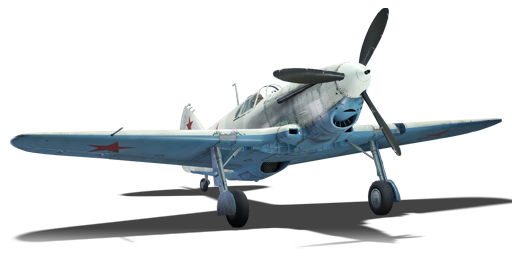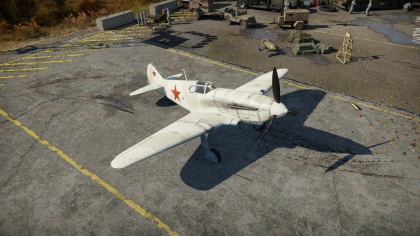Difference between revisions of "LaGG-3-8"
(Added basic information and tables.) |
m (Added disambiguation link.) |
||
| Line 1: | Line 1: | ||
{{Specs-Card|code=lagg-3-8}} | {{Specs-Card|code=lagg-3-8}} | ||
| − | + | {{Notice|''This page is about the aircraft '''{{PAGENAME}}'''. For other uses, see [[LaGG-3_(Disambiguation)|LaGG-3 (Disambiguation)]]''}} | |
== Description == | == Description == | ||
<!--''In the description, the first part needs to be about the history of and the creation and combat usage of the aircraft, as well as its key features. In the second part, tell the reader about the aircraft in the game. Insert screenshot of the vehicle. If the novice player does not remember the vehicle by name, he will immediately understand what kind of vehicle it is talking about.''--> | <!--''In the description, the first part needs to be about the history of and the creation and combat usage of the aircraft, as well as its key features. In the second part, tell the reader about the aircraft in the game. Insert screenshot of the vehicle. If the novice player does not remember the vehicle by name, he will immediately understand what kind of vehicle it is talking about.''--> | ||
Revision as of 14:29, 9 January 2019
Contents
| This page is about the aircraft LaGG-3-8. For other uses, see LaGG-3 (Disambiguation) |
Description
The LaGG-3-8 is a Rank I Soviet fighter with a battle rating of 2.3 (AB), 2.0 (RB), and 1.7 (SB). It was introduced in Update 1.33.
The LaGG-3-8 is one of the first aircraft in the game to be armed with a cannon. It is also one of three Soviet fighters in Rank I to be armed with a cannon, the others being the LaGG-3-11 and Yak-1. As the first monoplane fighter for many Rank I Soviet pilots, a big change from the reserve tier biplanes, it is an introduction to a whole new range of tactics and armaments.
General info
Flight Performance
| Characteristics | |||||||
|---|---|---|---|---|---|---|---|
| Stock | |||||||
| Max Speed (km/h at 5,000 m) |
Max altitude (meters) |
Turn time (seconds) |
Rate of climb (meters/second) |
Take-off run (meters) | |||
| AB | RB | AB | RB | AB | RB | ||
| 528 | 516 | 9,000 | 25.6 | 26.4 | 7.7 | 7.7 | 400 |
| Upgraded | |||||||
| Max Speed (km/h at 5,000 m) |
Max altitude (meters) | Turn time (seconds) | Rate of climb (meters/second) |
Take-off run (meters) | |||
| AB | RB | AB | RB | AB | RB | ||
| 581 | 554 | 9,000 | 22.4 | 24.0 | 16.5 | 10.5 | 400 |
Details
| Features | ||||
|---|---|---|---|---|
| Combat flap | Take-off flap | Landing flap | Air brakes | Arrestor gear |
| ✓ | ✓ | ✓ | X | X |
| Limits | ||||
|---|---|---|---|---|
| Wing-break speed (km/h) |
Gear limit (km/h) |
Combat flap (km/h) |
Max Static G | |
| + | - | |||
| 680 | 420 | ??? | ~21 | ~21 |
| Optimal velocities | |||
|---|---|---|---|
| Ailerons (km/h) |
Rudder (km/h) |
Elevators (km/h) |
Radiator (km/h) |
| < 380 | < 380 | < 450 | > 290 |
| Compressor (RB/SB) | ||
|---|---|---|
| Setting 1 | ||
| Optimal altitude | 100% Engine power | WEP Engine power |
| 2,000 m | 1,100 hp | 1,232 hp |
| Setting 2 | ||
| Optimal altitude | 100% Engine power | WEP Engine power |
| 4,300 m | 1,050 hp | 1,176 hp |
Survivability and armour
- 8 mm Steel plate behind the pilot.
- No armour glazing
- Critical components located at front of aircraft (fuel, pilot, engine, controls)
- More fuel tanks located in wings near fuselage
Armaments
Offensive armament
The LaGG-3-8 is armed with:
- 1× 20 mm ShVAK cannon, nose-mounted (150 rpg)
- 1× 12.7 mm Berezin UB machine gun, nose-mounted (200 rpg)
Usage in the battles
The LaGG-3-8 should be flown mainly as a fighter. It can be used as a bomber hunter, but it is not well suited to this role due to its average rate of climb and fragile engine.
As a fighter, the LaGG-3-8 packs quite a punch at its low tier. The powerful cannon in the nose of the plane allows it to potentially dish out large amounts of damage to unsuspecting aircraft, biplanes, monoplanes and bombers alike. Its heavy armament makes it the perfect aircraft to pounce on carefully selected enemies that are on their own or engaged in a furball at low altitudes. Due to the average rate of climb, this aircraft is best used in diving attacks, booming and zooming in and out of the fray.
Another feasible tactic in the LaGG-3-8 is to take advantage of the nose centred armament in head-on attacks. Due to the aircraft's fairly robust airframe, it can take some hits in most areas, even from 20 mm cannons. When performing a head-on attack in the LaGG-3-8, take advantage of the central armament to take some shots from more than 750 m out, then pitching down and pulling to the side slightly. If you see that your opponent has committed to the head-on, pull the aircraft back on target and fire in long bursts.
If up against a fighter or single engine aircraft, aim for the main mass of the plane, the fuselage. If up against a heavy fighter or bomber, aim for a single engine or wing. Usually a burst of cannon fire into these areas will do them in. If you happen to come up against an aircraft with similar armament (central cannons), take a few pot shots, roll and dive out of the fight to a safe distance. However, against most other planes, the nose mounted armament of the LaGG-3-8 excels. Another thing to watch out for is the plane's fragile engine, as it can be easily knocked out by aircraft with heavier armament in head-on attacks.
At this low tier there are many planes that can out-turn the LaGG-3-8. Although this aircraft can pull a very fast initial turn, in a sustained turn-fight it will start to show its faults. Its weak engine combined with a heavy airframe means that this aircraft bleeds energy very quickly in tight turns, nosing down during long, low speed turns. Once at this state of low energy, its average climb rate and acceleration worsens, posing it as an easy target for even the slowest of fighters.
In summary, the main points to take note of when flying this aircraft are:
- Keep your speed and energy up
- Use your dive speed and nose mounted cannon to your advantage
- Go for unsuspecting targets when alone or in furballs
- Perform head-on attacks against weaker targets
- Don't engage in a sustained turn fight
- Try not to get the engine damaged
Manual Engine Control
| MEC elements | ||||||
|---|---|---|---|---|---|---|
| Mixer | Pitch | Radiator | Supercharger | Turbocharger | ||
| Oil | Water | Type | ||||
| Controllable | Not controllable | Not controllable | Not controllable | Separate | Not ontrollable | Not controllable |
Modules
| Tier | Flight performance | Survivability | Weaponry | |
|---|---|---|---|---|
| I | Fuselage Repair | Radiator | Offensive 12 mm | |
| II | Compressor | New 12 mm MGs | ||
| III | Wings Repair | Engine | Offensive 20 mm | |
| IV | Engine Injection | Cover | New 20 mm Cannons | |
Pros and cons
Pros:
- Relatively fast for its battle rating
- Good diving speeds
- Average turn time
- Fairly good roll rate
- Strong armament for its battle rating
- Reasonably high cannon ammunition capacity (150 rounds)
- Armament centered in nose
- Easy to fly
Cons:
- Rate of climb is average at best due to weight and weak engine
- Can be out-turned easily by biplanes
- to nose down in sustained low speed turns
- Low machine gun ammunition capacity (200 rounds)
- Cannon and machine gun rounds follow different trajectories
- Engine overheats and can be knocked out quite easily (liquid-cooled)
History
The LaGG-3 was designed by Soviet engineers Lavochkin, Gorbunov, and Gudkov to replace the LaGG-1. The original LaGG-3 prototype was made almost entirely out of wood. The air frame was made out of special multi-ply wood bonded with resin. The wings were similar to that of the Yak-1, the difference being the LaGG wing was made in two sections. The fuselage was similar to another Russian fighter, the MiG-3. Armament includes a 20 mm ShVAK rapid-fire cannon with 150 rpg mounted in a hollow shaft. A 12.7 mm Berezin machine gun was synchronized and mounted on the engine cowling with 170 rpg. The LaGG-3 had many problems during production, the Klimov M-106 engine was powerful but unreliable. The Klimov M105 however was more reliable but weaker. This led to the LaGG-3 being severely under powered, and disliked by many pilots. This led to Lavochkin's decision to install a more powerful Shvetsov M-82 radial. Which gave birth to one of the most feared fighters in the game: the La-5.
Media
An excellent addition to the article will be video guides, as well as screenshots from the game and photos.
Read also
Sources
Paste links to sources and external resources, such as:
- topic on the official game forum;
- page on aircraft encyclopedia;
- other literature.
| USSR fighters | |
|---|---|
| I-15 | I-15 WR · I-15 M-22 · I-15 M-25 · I-15bis · Krasnolutsky's I-15bis |
| I-153 M-62 · Zhukovsky's I-153-M62 · I-153P | |
| I-16 | I-16 type 5 · I-16 type 10 · I-16 type 18 · I-16 type 24 · I-16 type 27 · I-16 type 28 · I-180S |
| I-29 | I-29 |
| I-185 | I-185 (M-71) · I-185 (M-82) |
| I-225 | I-225 |
| ITP | ITP (M-1) |
| MiG-3 | MiG-3-15 · MiG-3-15 (BK) · MiG-3-34 |
| LaGG | I-301 · LaGG-3-4 · LaGG-3-8 · LaGG-3-11 · LaGG-3-23 · LaGG-3-34 · LaGG-3-35 · LaGG-3-66 |
| La | La-5 · La-5F · La-5FN · La-7 · Dolgushin's La-7 · La-7B-20 · La-9 · La-11 |
| Yak-1/7 | Yak-1 · Yak-1B · Yak-7B |
| Yak-3 | Yak-3 · Eremin's Yak-3(e) · Yak-3P · Yak-3T · Yak-3U · Yak-3 (VK-107) |
| Yak-9 | Yak-9 · Yak-9B · Golovachev's Yak-9M · Yak-9T · Yak-9K · Yak-9U · Yak-9UT · Yak-9P |
| Other countries | ▂P-40E-1 · ▂P-47D-27 · ▂Hurricane Mk IIB · ▂Fw 190 D-9 · ▂Spitfire Mk IXc |
| P-39 | ▂P-39K-1 · ▂Pokryshkin's P-39N-0 · ▂P-39Q-15 |
| P-63 | ▂P-63A-5 · ▂P-63A-10 · ▂P-63C-5 |





